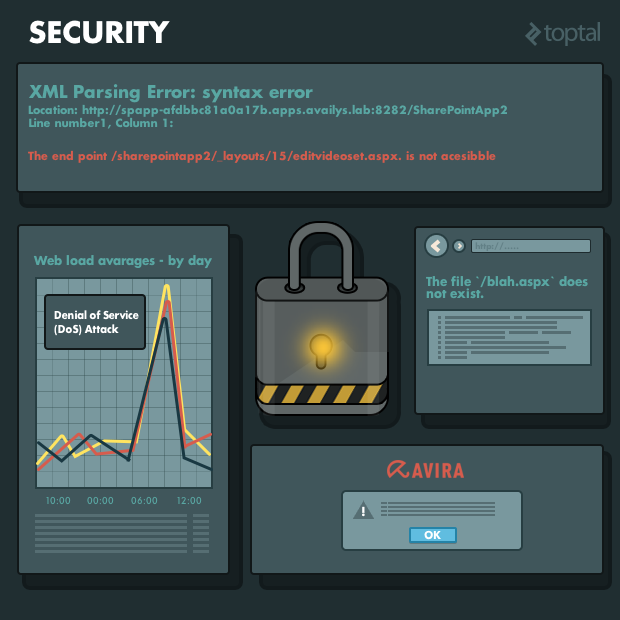Gergely Kalman at Toptal wrote a good article on the top 10 most common web security vulnerabilities. The original article can be found HERE. On with the article …
For all too many companies, it’s not until after a breach has occurred that web security becomes a priority. During my years working as an IT Security professional, I have seen time and time again how obscure the world of IT Security is to so many of my fellow programmers.
An effective approach to IT security must, by definition, be proactive and defensive. Toward that end, this post is aimed at sparking a security mindset, hopefully injecting the reader with a healthy dose of paranoia.
In particular, this guide focuses on 10 common and significant web security pitfalls to be aware of, including recommendations on how they can be avoided. The focus is on the Top 10 Web Vulnerabilities identified by the Open Web Application Security Project (OWASP), an international, non-profit organization whose goal is to improve software security across the globe.
A little web security primer before we start – authentication and authorization
When speaking with other programmers and IT professionals, I often encounter confusion regarding the distinction between authorization and authentication. And of course, the fact the abbreviation auth is often used for both helps aggravate this common confusion. This confusion is so common that maybe this issue should be included in this post as “Common Web Vulnerability Zero”.
So before we proceed, let’s clearly the distinction between these two terms:
- Authentication: Verifying that a person is (or at least appears to be) a specific user, since he/she has correctly provided their security credentials (password, answers to security questions, fingerprint scan, etc.).
- Authorization: Confirming that a particular user has access to a specific resource or is granted permission to perform a particular action.
Stated another way, authentication is knowing who an entity is, while authorization is knowing what a given entity can do.
Common Mistake #1: Injection flaws
Injection flaws result from a classic failure to filter untrusted input. It can happen when you pass unfiltered data to the SQL server (SQL injection), to the browser (XSS – we’ll talk about this later), to the LDAP server (LDAP injection), or anywhere else. The problem here is that the attacker can inject commands to these entities, resulting in loss of data and hijacking clients’ browsers.
Anything that your application receives from untrusted sources must be filtered, preferably according to a whitelist. You should almost never use a blacklist, as getting that right is very hard and usually easy to bypass. Antivirus software products typically provide stellar examples of failing blacklists. Pattern matching does not work.
Prevention: The good news is that protecting against injection is “simply” a matter of filtering your input properly and thinking about whether an input can be trusted. But the bad news is that all input needs to be properly filtered, unless it can unquestionably be trusted (but the saying “never say never” does come to mind here).
In a system with 1,000 inputs, for example, successfully filtering 999 of them is not sufficient, as this still leaves one field that can serve as the Achilles heal to bring down your system. And you might think that putting an SQL query result into another query is a good idea, as the database is trusted, but if the perimeter is not, the input comes indirectly from guys with malintent. This is called Second Order SQL Injection in case you’re interested.
Since filtering is pretty hard to do right (like crypto), what I usually advise is to rely on your framework’s filtering functions: they are proven to work and are thoroughly scrutinized. If you do not use frameworks, you really need to think hard about whether not using them really makes sense in your environment. 99% of the time it does not.
Common Mistake #2: Broken Authentication
This is a collection of multiple problems that might occur during broken authentication, but they don’t all stem from the same root cause.
Assuming that anyone still wants to roll their own authentication code in 2014 (what are you thinking??), I advise against it. It is extremely hard to get right, and there are a myriad of possible pitfalls, just to mention a few:
- The URL might contain the session id and leak it in the referer header to someone else.
- The passwords might not be encrypted either in storage or transit.
- The session ids might be predictable, thus gaining access is trivial.
- Session fixation might be possible.
- Session hijacking might be possible, timeouts not implemented right or using HTTP (no SSL), etc…
Prevention: The most straightforward way to avoid this web security vulnerability is to use a framework. You might be able to implement this correctly, but the former is much easier. In case you do want to roll your own code, be extremely paranoid and educate yourself on what the pitfalls are. There are quite a few.
Common Mistake #3: Cross Site Scripting (XSS)
This is a fairly widespread input sanitization failure (essentially a special case of common mistake #1). An attacker gives your web application JavaScript tags on input. When this input is returned to the user unsanitized, the user’s browser will execute it. It can be as simple as crafting a link and persuading a user to click it, or it can be something much more sinister. On page load the script runs and, for example, can be used to post your cookies to the attacker.
Prevention: There’s a simple web security solution: don’t return HTML tags to the client. This has the added benefit of defending against HTML injection, a similar attack whereby the attacker injects plain HTML content (such as images or loud invisible flash players) – not high-impact but surely annoying (“please make it stop!”). Usually, the workaround is simply converting all HTML entities, so that <script> is returned as <script>. The other often employed method of sanitization is using regular expressions to strip away HTML tags using regular expressions on < and >, but this is dangerous as a lot of browsers will interpret severely broken HTML just fine. Better to convert all characters to their escaped counterparts.
Common Mistake #4: Insecure Direct Object References
This is a classic case of trusting user input and paying the price in a resulting security vulnerability. A direct object reference means that an internal object such as a file or database key is exposed to the user. The problem with this is that the attacker can provide this reference and, if authorization is either not enforced (or is broken), the attacker can access or do things that they should be precluded from.
For example, the code has a download.php module that reads and lets the user download files, using a CGI parameter to specify the file name (e.g., download.php?file=something.txt). Either by mistake or due to laziness, the developer omitted authorization from the code. The attacker can now use this to download any system files that the user running PHP has access to, like the application code itself or other data left lying around on the server, like backups. Uh-oh.
Another common vulnerability example is a password reset function that relies on user input to determine whose password we’re resetting. After clicking the valid URL, an attacker can just modify the username field in the URL to say something like “admin”.
Incidentally, both of these examples are things I myself have seen appearing often “in the wild”.
Prevention: Perform user authorization properly and consistently, and whitelist the choices. More often than not though, the whole problem can be avoided by storing data internally and not relying on it being passed from the client via CGI parameters. Session variables in most frameworks are well suited for this purpose.
Common Mistake #5: Security misconfiguration
In my experience, web servers and applications that have been misconfigured are way more common than those that have been configured properly. Perhaps this because there is no shortage of ways to screw up. Some examples:
- Running the application with debug enabled in production.
- Having directory listing enabled on the server, which leaks valuable information.
- Running outdated software (think WordPress plugins, old PhpMyAdmin).
- Having unnecessary services running on the machine.
- Not changing default keys and passwords. (Happens way more frequently than you’d believe!)
- Revealing error handling information to the attackers, such as stack traces.
Prevention: Have a good (preferably automated) “build and deploy” process, which can run tests on deploy. The poor man’s security misconfiguration solution is post-commit hooks, to prevent the code from going out with default passwords and/or development stuff built in.
Common Mistake #6: Sensitive data exposure
This web security vulnerability is about crypto and resource protection. Sensitive data should be encrypted at all times, including in transit and at rest. No exceptions. Credit card information and user passwords should never travel or be stored unencrypted, and passwords should always be hashed. Obviously the crypto/hashing algorithm must not be a weak one – when in doubt, use AES (256 bits and up) and RSA (2048 bits and up).
And while it goes without saying that session IDs and sensitive data should not be traveling in the URLs and sensitive cookies should have the secure flag on, this is very important and cannot be over-emphasized.
Prevention:
- In transit: Use HTTPS with a proper certificate and PFS (Perfect Forward Secrecy). Do not accept anything over non-HTTPS connections. Have the secure flag on cookies.
- In storage: This is harder. First and foremost, you need to lower your exposure. If you don’t need sensitive data, shred it. Data you don’t have can’t be stolen. Do not store credit card information ever, as you probably don’t want to have to deal with being PCI compliant. Sign up with a payment processor such as Stripe or Braintree. Second, if you have sensitive data that you actually do need, store it encrypted and make sure all passwords are hashed. For hashing, use of bcrypt is recommended. If you don’t use bcrypt, educate yourself on salting and rainbow tables.
And at the risk of stating the obvious, do not store the encryption keys next to the protected data. That’s like storing your bike with a lock that has the key in it. Protect your backups with encryption and keep your keys very private. And of course, don’t lose the keys!
Common Mistake #7: Missing function level access control
This is simply an authorization failure. It means that when a function is called on the server, proper authorization was not performed. A lot of times, developers rely on the fact that the server side generated the UI and they think that the functionality that is not supplied by the server cannot be accessed by the client. It is not as simple as that, as an attacker can always forge requests to the “hidden” functionality and will not be deterred by the fact that the UI doesn’t make this functionality easily accessible. Imagine there’s an /admin panel, and the button is only present in the UI if the user is actually an admin. Nothing keeps an attacker from discovering this functionality and misusing it if authorization is missing.
Prevention: On the server side, authorization must always be done. Yes, always. No exceptions or vulnerabilities will result in serious problems.
Common Mistake #8: Cross Site Request Forgery (CSRF)
This is a nice example of a confused deputy attack whereby the browser is fooled by some other party into misusing its authority. A 3rd party site, for example, can make the user’s browser misuse it’s authority to do something for the attacker.
In the case of CSRF, a 3rd party site issues requests to the target site (e.g., your bank) using your browser with your cookies / session. If you are logged in on one tab on your bank’s homepage, for example, and they are vulnerable to this attack, another tab can make your browser misuse its credentials on the attacker’s behalf, resulting in the confused deputy problem. The deputy is the browser that misuses its authority (session cookies) to do something the attacker instructs it to do.
Consider this example:
Attacker Alice wants to lighten target Todd’s wallet by transfering some of his money to her. Todd’s bank is vulnerable to CSRF. To send money, Todd has to access the following URL:
http://example.com/app/transferFunds?amount=1500&destinationAccount=4673243243
After this URL is opened, a success page is presented to Todd, and the transfer is done. Alice also knows, that Todd frequently visits a site under her control at blog.aliceisawesome.com, where she places the following snippet:
<img src="http://example.com/app/transferFunds?amount=1500&destinationAccount=4673243243" width="0" height="0" />Upon visiting Alice’s website, Todd’s browser thinks that Alice links to an image, and automatically issues an HTTP GET request to fetch the “picture”, but this actually instructs Todd’s bank to transfer $1500 to Alice.
Incidentally, in addition to demonstrating the CSRF vulnerability, this example also demonstrates altering the server state with an idempotent HTTP GET request which is itself a serious vulnerability. HTTP GET requests must be idempotent (safe), meaning that they cannot alter the resource which is accessed. Never, ever, ever use idempotent methods to change the server state.
Fun fact: CSRF is also the method people used for cookie-stuffing in the past until affiliates got wiser.
Prevention: Store a secret token in a hidden form field which is inaccessible from the 3rd party site. You of course always have to verify this hidden field. Some sites ask for your password as well when modifying sensitive settings (like your password reminder email, for example), although I’d suspect this is there to prevent the misuse of your abandoned sessions (in an internet cafe for example).
Common Mistake #9: Using components with known vulnerabilities
The title says it all. I’d again classify this as more of a maintenance/deployment issue. Before incorporating new code, do some research, possibly some auditing. Using code that you got from a random person on GitHub or some forum might be very convenient, but is not without risk of serious web security vulnerability.
I have seen many instances, for example, where sites got owned (i.e., where an outsider gains administrative access to a system), not because the programmers were stupid, but because a 3rd party software remained unpatched for years in production. This is happening all the time with WordPress plugins for example. If you think they will not find your hidden phpmyadmin installation, let me introduce you to dirbuster.
The lesson here is that software development does not end when the application is deployed. There has to be documentation, tests, and plans on how to maintain and keep it updated, especially if it contains 3rd party or open source components.
Prevention:
- Exercise caution. Beyond obviously using caution when using such components, do not be a copy-paste coder. Carefully inspect the piece of code you are about to put into your software, as it might be broken beyond repair (or in some cases, intentionally malicious).
- Stay up-to-date. Make sure you are using the latest versions of everything that you trust, and have a plan to update them regularly. At least subscribe to a newsletter of new security vulnerabilities regarding the product.
Common Mistake #10: Unvalidated redirects and forwards
This is once again an input filtering issue. Suppose that the target site has a redirect.php module that takes a URL as a GET parameter. Manipulating the parameter can create a URL on targetsite.com that redirects the browser to malwareinstall.com. When the user sees the link, they will see targetsite.com/blahblahblah which the user thinks is trusted and is safe to click. Little do they know that this will actually transfer them onto a malware drop (or any other malicious) page. Alternatively, the attacker might redirect the browser to targetsite.com/deleteprofile?confirm=1.
It is worth mentioning, that stuffing unsanitized user-defined input into an HTTP header might lead to header injection which is pretty bad.
Prevention: Options include:
- Don’t do redirects at all (they are seldom necessary).
- Have a static list of valid locations to redirect to.
- Whitelist the user-defined parameter, but this can be tricky.
Epilogue
I hope that I have managed to tickle your brain a little bit with this post and to introduce a healthy dose of paranoia and web security vulnerability awareness.
The core takeaway here is that age-old software practices exist for a reason and what applied back in the day for buffer overflows, still apply for pickled strings in Python today. Security helps you write correct(er) programs, which all programmers should aspire to.
Please use this knowledge responsibly, and don’t test pages without permission!
For more information and more specific attacks, have a look at: https://www.owasp.org/index.php/Category:Attack.
Feedback on this post is welcome and appreciated. Future related posts are planned, particularly on the issue of distributed denial-of-service (DDoS) and old-school (not web) IT security vulnerabilities. If you have a specific request on what to write about, please feel free to contact me directly at [email protected].






Hi there friends, its impressive post about educationand
completely defined, keep it up all the time.